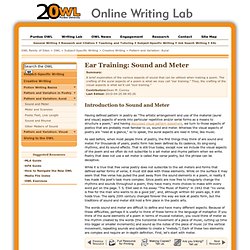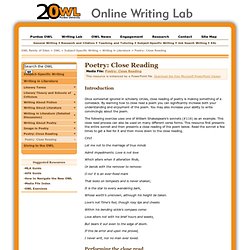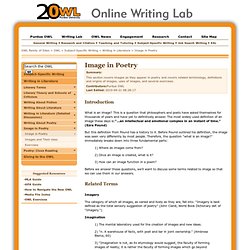

Tone Terms. List of Feelings. Pattern and Variation: Aural. Summary: A brief exploration of the various aspects of sound that can be utilized when making a poem.

The crafting of the aural aspects of a poem is what we may call "ear training. " Thus, the crafting of the visual aspects is what we'd call "eye training. " Contributors:Sean M. ConreyLast Edited: 2010-04-25 08:45:26 Introduction to Sound and Meter Having defined pattern in poetry as "The artistic arrangement and use of the material (aural and visual) aspects of words into particular repetitive and/or serial forms as a means to structure a poem," and having discussed visual pattern elsewhere, we turn to those aspects of poetics that are probably most familiar to us, sound and meter.
As said before, when most people think of poetry, the first things they think of are sound and meter. While it is true that free verse poetry does not subscribe to the set meters and forms that defined earlier forms of verse, it must still deal with these elements. Poetry: Close Reading. Introduction Once somewhat ignored in scholarly circles, close reading of poetry is making something of a comeback.

By learning how to close read a poem you can significantly increase both your understanding and enjoyment of the poem. You may also increase your ability to write convincingly about the poem. The following exercise uses one of William Shakespeare’s sonnets (#116) as an example. This close read process can also be used on many different verse forms. Let me not to the marriage of true minds Admit impediments. Which alters when it alteration finds, Or bends with the remover to remove: O no! That looks on tempests and is never shaken; It is the star to every wandering bark, Whose worth's unknown, although his height be taken. Love's not Time's fool, though rosy lips and cheeks Within his bending sickle's compass come: Love alters not with his brief hours and weeks, But bears it out even to the edge of doom. If this be error and upon me proved, I never writ, nor no man ever loved. Image in Poetry. Summary: This section covers images as they appear in poetry and covers related terminology, definitions and origins of images, uses of images, and several exercises.

Contributors:Purdue OWLLast Edited: 2010-04-21 08:28:17 Introduction. Explicating a Poem and Symbolism. Writing About Poetry. Summary: This section covers the basics of how to write about poetry.

Including why it is done, what you should know, and what you can write about. Contributors:Purdue OWLLast Edited: 2010-04-21 08:27:54 Writing about poetry can be one of the most demanding tasks that many students face in a literature class. Poetry, by its very nature, makes demands on a writer who attempts to analyze it that other forms of literature do not. What's the Point? In order to write effectively about poetry, one needs a clear idea of what the point of writing about poetry is.
So why would your teacher give you such an assignment? To help you learn to make a text-based argument. What Should I Know about Writing about Poetry? Most importantly, you should realize that a paper that you write about a poem or poems is an argument. What Can I Write About? Theme: One place to start when writing about poetry is to look at any significant themes that emerge in the poetry. Genre: What kind of poem are you looking at?